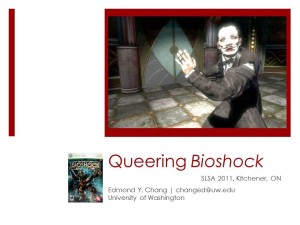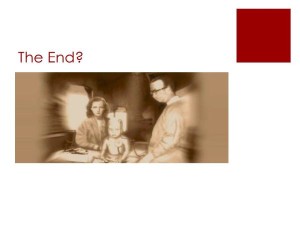I have recently returned from a very nice trip to Kitchener, ON (though flying cross continent is always a little bit trying), where I attended the Society for Literature, Science, and the Arts (SLSA) annual conference. My third SLSA, I was once again impressed by the overall community of scholars, the interdisciplinarity, and the organization of the conference itself. I was fortunate to present as part of the Critical Game Studies stream organized by Patrick Jagoda. My panel “Critical Game Studies IV: Videogame Spaces and Posthuman Agents” consisted of my good friend Timothy Welsh and the illustrious Steven E. Jones. Even though there were some technical difficulties, the panel was very successful. I received a number of positive responses to both the panel and my paper in particular. Thanks to everyone who came to the game studies stream, who supported all of our projects, and to my new colleagues and peers.
Below is the write-up of my presentation, briefly titled “Queering Bioshock,” which is a distillation of some of the ideas from my second chapter of my dissertation. More of a meditation, my argument focuses on the elision and collision between the queer possibilities of posthumanism (more specifically transhumanism), of the cyborg medium of video games, and of the narrative and algorithmic promises of the game Bioshock. I argue that the radical possibilities of the game and what it represents are ultimately foreclosed and recuperated back into hetero- and technonormativity.
 “Queering Bioshock”
“Queering Bioshock”
Presented at SLSA, September 22-25, 2011, Kitchener, Ontario
Edmond Y. Chang
I want to layout three frames:
First, a broad engagement with the concerns and possibilities of the technological mediation of and integration with subjectivity and embodiment or shorthanded here as the posthuman. Cary Wolfe defines posthumanism as the “historical moment in which the decentering of the human by its imbrication in technical, medical, informatic, and economic networks is increasingly impossible to ignore” (xv). Imaginings of posthumanity are decidedly polar. Dystopian fears over machine intelligence, cloning, infocalypse, and the loss of life, liberty, and humanity on the one hand. On the other hand are dreams of transcendence, immortality, global harmony, and enlightenment. What I want to highlight here is the latter, addressing particularly the idea that technology will ultimately make people (and society) better, stronger, faster, a brand of posthumanism or more precisely transhumanism that Wolfe critiques as merely the intensification of traditional liberal humanism. In fact, the World Transhumanist Association (now repackaged as Humanity+) espouses “the feasibility of redesigning the human condition, including such parameters as the inevitability of aging, limitations on human artificial intellects, unchosen psychology, suffering, and our confinement to the planet earth.”
The second frame is video game technology and video game culture and the mainstream belief that video games empower players with choice, control, exploration, even escape. Given recent rhetorics of interactivity and immersion, of sandbox synthetic worlds, of democratization through gamification, I want to situate video games as a vernacular posthuman technology using Bioshock as my example. Bioshock, as Alexander Galloway argues of video games “renders social realities in playable form,” dramatizing the posthuman possibility and transhumanist fantasy of technological self-fashioning, possessive individualism, and liberation from the limitations of embodiment through what Timothy Welsh (who could not be here today) and I have called the cyborg medium of video games. However, it is important to question this fantasy, as Galloway further warns: “the more emancipating games seem to be as a medium…they more they are in fact hiding the fundamental social transformation into informatics” (106). In other words, even as a video game evinces a player’s power and agency, it naturalizes and obscures its algorithmic control.
The final frame is Bioshock itself and its rich game world. Bioshock is set in 1960 and takes place in Rapture, an underwater utopian city-state modeled on Ayn Randian objectivist philosophy. However, when the player-protagonist, Jack, arrives in Rapture after his plane crashes in the ocean, the city is near collapse after the introduction of bodyhacking technology called “splicing,” which results in civil war between the “humans” and the posthuman “splicers.” In the opening cinematic, we are introduced to the mastermind behind Rapture, an entrepreneur and visionary named Andrew Ryan (clearly rhyming Ayn Rand) who proclaims the city’s manifesto and the central dilemmas of the game:
“A man has choices, I chose the impossible. I built a city where the artists would not fear the censor, where the great would not be constrained by the small, where the scientist would not be bound by petty morality. I chose to build Rapture. But my city was betrayed by the weak. So I ask you my friend, if you live with pride, would you kill the innocent? Would you sacrifice your humanity? We all make choices, but in the end, our choices make us.”
With these three frames, my goal here is not to do a “straight” (pardon the pun) queer reading of the game, meaning I don’t want to just go bird watching for queer characters. Rather, because Bioshock dramatizes the transhumanist dream of self-fashioning via splicing and because the game relies on the interactive fallacy of video game freedom and control, I want to argue that the game invites queer possibilities that might be leveraged to critique normative gender, sexuality, even race. But, as we will see, the game forecloses on these possibilities recuperating them back into hetero- and technonormativity.
But back to Jack.
 The player-protagonist is thrust into Rapture, is introduced to splicing technology, and must navigate not only the crumbling city but also the political factions at war. In order to escape Rapture, Jack is led to believe he must help a resistance fighter named Atlas (another Randian reference) and overthrow Andrew Ryan. Aside from the usual first-person shooter arsenal of guns, ammo, and the ever-popular pipe wrench, the player-protagonist is enhanced by splicing technology (called plasmids) derived from a deep sea slug. Adam and Eve, derivatives of the sea slug, allow the player-protagonist to enhance health, strength, skills, and grants an array of superhuman powers like throwing lightning and telekinesis. Mapped on to these technologies are the libertarian and individualist mores of Rapture’s society, which promises freedom for all to be beautiful, talented, rich, and powerful.
The player-protagonist is thrust into Rapture, is introduced to splicing technology, and must navigate not only the crumbling city but also the political factions at war. In order to escape Rapture, Jack is led to believe he must help a resistance fighter named Atlas (another Randian reference) and overthrow Andrew Ryan. Aside from the usual first-person shooter arsenal of guns, ammo, and the ever-popular pipe wrench, the player-protagonist is enhanced by splicing technology (called plasmids) derived from a deep sea slug. Adam and Eve, derivatives of the sea slug, allow the player-protagonist to enhance health, strength, skills, and grants an array of superhuman powers like throwing lightning and telekinesis. Mapped on to these technologies are the libertarian and individualist mores of Rapture’s society, which promises freedom for all to be beautiful, talented, rich, and powerful.
It is in this setting that we find Sander Cohen. Though the game does not out Cohen, there is enough textual evidence to support reading him as the stereotypical Hollywood or Broadway fey fatale: he is the “boss” of the seventh level and pleasure zone Fort Frolic, which is full of bars, theaters, strip clubs, and boutiques; he is a suffering artist, musician, and director given to lavish melodramatics, composing in one audio diary “The Wild Bunny:”
I want to take the ears off, but I can’t.
I hop, and when I hop, I never get off the ground.
It’s my curse, my eternal curse!
I want to take the ears off but I can’t!
It’s my curse! It’s my fucking curse!
I want to take the ears off!
Please!
Take them off!
Please!
The undertext of the closet here are undeniable. However, what is more compelling is that Cohen vindictively requires Jack to kill the remaining three of four of his young, male protégés.
In the confrontation with Silas Cobb, one of Cohen’s favorites, Cobb reveals, “I used to love you, I used to think you were a musical genius. You know why? Because you paid my rent, you ancient hack!” He later spits at Jack, “It’s all a game, errand boy! Cohen, Ryan! Two old birds pullin’ on each other’s milk sticks!”
What is important here is that Cohen simultaneously perpetuates a stereotypical representation of the homo-homicidal aesthete, complete with dance numbers and bitchy repartee, and a game space and embodiment open to queerness where “artists would not fear the censor.” Unfortunately, in order to proceed in the game, the player-protagonist must defeat Cohen. Cohen’s descent into madness and death censors him, recuperates him. According to VorpalBunny, a contributor to gaygamer.net, who extends the queer reading to include a possible connection between Cohen and Ryan himself, the developers wanted to make Cohen a fully-fledge character. According to the developers, the wanted to “create human beings, which meant that everyone was treated equally. Everyone also had the same capacity to fall and become depraved killers.” Of course, all of this talk of equality obscures the problematic logics at work in Cohen’s characterization and reveals a failure to recast the intersections of queerness, technology, and agency. Or as Thomas Foster argues in The Souls of Cyberfolk, “The point of potential intersection between posthumanism and new social movements like feminism, gay and lesbian liberation, and civil rights, and black nationalism resides in the claim that the inability to imagine the possibility of [posthuman subjects like] truly intelligent machines (or human-machine hybrids or clones or genetically engineered children) demonstrates the same narrow concept of personhood used to legitimate racism, sexism, and homophobia” (xxvi).
I argue that it is this inevitability required by the game’s programming and narrative and by the larger, cultural policing of queerness that reveal the ambivalent positioning of the player and protagonist in gaming’s posthuman fantasies. Foster says, “The key antinomy or unbridgeable gap that posthumanism has trouble thinking through is…the relation between the argument that posthumanism has critical potential…and the argument that posthumanism dismisses such struggles or even makes them obsolete, just as in some accounts of new technologies of body modification and human-computer interfaces are understood as making bodies obsolete” (xxvii). In other words, in a game world and a cyborg medium that argues for a kind of techno-possessive individualism and liberation from the limits of the mind, body, and culture, Bioshock enacts its critique of Randian objectivism and posthuman choice via itself. (It tries to, anyway.)
In fact, central to the game is the showdown between Jack and Andrew Ryan. Until this aptly titled level “All Is Revealed,” Jack believes himself to have discovered Rapture and become trapped in its civil war by chance and accident. What is revealed in the confrontation with father of Rapture, however, is that Jack was in fact born in Rapture, fathered by Ryan himself, and bioengineered to be the inheritor and defender of the utopia. Most importantly, what is revealed is that Jack’s body modifications included mind-control implants, which are triggered by the polite request, “Would you kindly?” The player and protagonist overlappingly realize that they have been duped by the game and the game world.
As I said earlier, video games seduce their players with fantasies of power and control, the chance to play as super-human heroes battling injustice and oppression. Yet, I argue that the one power gaming can never fully offer its player is choice. The player is always caught between gamic action and algorithmic control. In the “All is Revealed” scene, Bioshock violates the player’s trust that the game will reveal to him or her how to inhabit and navigate the game world. However, in that positioning, it is telling him or her “Would you kindly move forward?” “Would you kindly kill that boss?” “Would you kindly win the game by playing the game this way?” Even as Ryan screams, “A man chooses, a slave obeys,” and commands the player-protagonist to kill him with the golf club, the game dramatizes the “key antimony” of posthumanism, the irony that these technologies can serve both liberation and domination. Or in the words of Donna Haraway, “from all work to all play, a deadly game.”
 Alas, as with the example of Sander Cohen, Bioshock does not end the game at the defeat of Andrew Ryan. Instead, the game extends the narrative by forcing the player-protagonist to seek out and defeat the “true” end boss, Frank Fontaine, who is Ryan’s rival and who has ultimately been manipulating Jack, too. Luckily, Jack is given the ability to overcome the “Would You Kindly” mind-control, and with the defeat of Fontaine, an end gambit with no more nuance than a tank-and-spank, Jack escapes Rapture and restores his status as hero in full possession of his individuality and free will. The player then is also recuperated and fed back into the interactive fallacy.
Alas, as with the example of Sander Cohen, Bioshock does not end the game at the defeat of Andrew Ryan. Instead, the game extends the narrative by forcing the player-protagonist to seek out and defeat the “true” end boss, Frank Fontaine, who is Ryan’s rival and who has ultimately been manipulating Jack, too. Luckily, Jack is given the ability to overcome the “Would You Kindly” mind-control, and with the defeat of Fontaine, an end gambit with no more nuance than a tank-and-spank, Jack escapes Rapture and restores his status as hero in full possession of his individuality and free will. The player then is also recuperated and fed back into the interactive fallacy.
But how might we imagine and develop a different understanding of the posthuman possibilities offered by technology? Given the examples from Bioshock, how might we resist the move to recuperation and open queer opportunities? How might we read against the desire to restore Jack’s normative masculinity, normative family, and normative humanity and reposition him as already challenging these categories precisely because of his mediation and penetration by technology? And via Jack and Bioshock, how might we extend the critique to find ways to resist Haraway’s “informatics of domination” or N. Katherine Hayles’s “nightmare” world where bodies no longer matter? In other words, how might we reconfigure and resist what I call the technonormative matrix, the technologically enhanced and informatically infected version of Judith Butler’s heteronormative matrix, “the matrix of power and discursive relations that effectively produce and regulate the intelligibility of [person, sex, or sexuality] for us” (Bodies 42).
If the popular promises and mythologies of posthumanism is that of liberation, whether it is liberation from human frailty, singular identities, oppression, even mortality, then we must not give into the seductions of these narratives and technologies—in the way Bioshock and its players have—and we must be mindful of the ways that, in the words of Lisa Nakamura, “only too often does one person’s ‘liberation’ constitute another’s recontainment.”
Works Cited
Butler, Judith. Bodies That Matter. New York: Routledge, 1993.
Foster, Thomas. The Souls of Cyberfolk: Posthumanism as Vernacular Theory. Minneapolis, MN: University of Minnesota Press, 2005.
Galloway, Alexander. Gaming: Essays on Algorithmic Culture. Minnesota, MN: University of Minnesota Press, 2006.
Nakamura, Lisa. Cybertypes: Race, Ethnicity, and Identity on the Internet. New York: Routledge, 2002.
VorpalBunny. “Queer Characters: Bioshock.” GayGaymer.net 24 Mar. 2011 <http://gaygamer.net/2011/03/queer_characters_bioshock.html>
Wolfe, Cary. What is Posthumanism? Minneapolis, MN: University of Minnesota Press, 2010.
World Transhumanist Association. 26 Jan. 2008. <http://www.transhumanism.org/index.php/WTA/index/>.